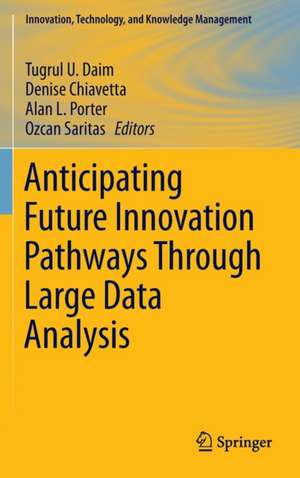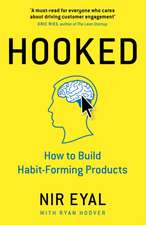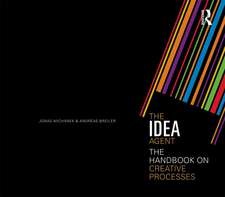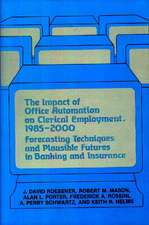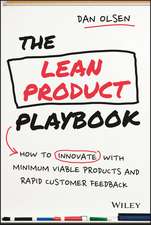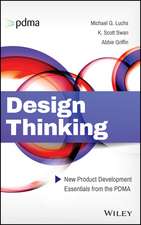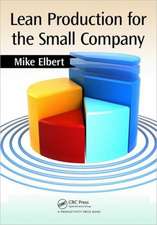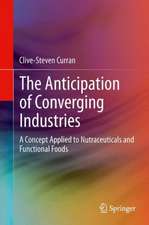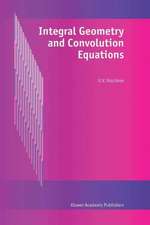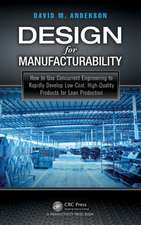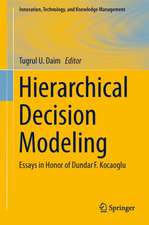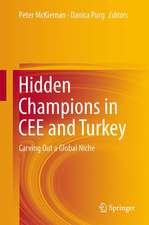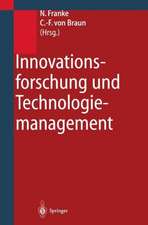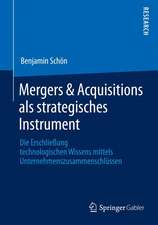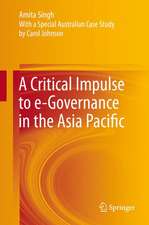Anticipating Future Innovation Pathways Through Large Data Analysis: Innovation, Technology, and Knowledge Management
Editat de Tugrul U. Daim, Denise Chiavetta, Alan L. Porter, Ozcan Saritasen Limba Engleză Hardback – 3 aug 2016
- The increasing availability of electronic text data resources relating to Science, Technology and Innovation (ST&I).
- The multiple methods that are able to treat this data effectively and incorporate means to tap into human expertise and interests.
- Translating those analyses to provide useful intelligence on likely future developments of particular emerging S&T targets.
Tech Mining can be defined as text analyses of ST&I information resources to generate Competitive Technical Intelligence (CTI). It combines bibliometrics and advanced text analytic, drawing on specialized knowledge pertaining to ST&I. Tech Mining may also be viewed as a special form of “Big Data” analytics because it searches on a target emerging technology (or key organization) of interest in global databases. One then downloads, typically, thousands of field-structured text records (usually abstracts), and analyses those for useful CTI. Forecasting Innovation Pathways (FIP) is a methodology drawing on Tech Mining plus additional steps to elicit stakeholder and expert knowledge to link recent ST&I activity to likely future development.
A decade ago, we demeaned Management of Technology (MOT) as somewhat self-satisfied and ignorant. Most technology managers relied overwhelmingly on casual human judgment, largely oblivious of the potential of empirical analyses to inform R&D management and science policy. CTI, Tech Mining, and FIP are changing that. The accumulation of Tech Mining research over the past decade offers a rich resource of means to get at emerging technology developments and organizational networks to date. Efforts to bridge from those recent histories ofdevelopment to project likely FIP, however, prove considerably harder. One focus of this volume is to extend the repertoire of information resources; that will enrich FIP.
Featuring cases of novel approaches and applications of Tech Mining and FIP, this volume will present frontier advances in ST&I text analytics that will be of interest to students, researchers, practitioners, scholars and policy makers in the fields of R&D planning, technology management, science policy and innovation strategy.
| Toate formatele și edițiile | Preț | Express |
|---|---|---|
| Paperback (1) | 948.47 lei 6-8 săpt. | |
| Springer International Publishing – 30 mai 2018 | 948.47 lei 6-8 săpt. | |
| Hardback (1) | 954.62 lei 6-8 săpt. | |
| Springer International Publishing – 3 aug 2016 | 954.62 lei 6-8 săpt. |
Din seria Innovation, Technology, and Knowledge Management
- 15%
 Preț: 643.99 lei
Preț: 643.99 lei -
 Preț: 281.97 lei
Preț: 281.97 lei - 15%
 Preț: 653.14 lei
Preț: 653.14 lei - 18%
 Preț: 945.62 lei
Preț: 945.62 lei - 18%
 Preț: 890.54 lei
Preț: 890.54 lei - 15%
 Preț: 640.06 lei
Preț: 640.06 lei -
 Preț: 383.93 lei
Preț: 383.93 lei - 15%
 Preț: 633.02 lei
Preț: 633.02 lei - 18%
 Preț: 1124.60 lei
Preț: 1124.60 lei - 18%
 Preț: 956.81 lei
Preț: 956.81 lei -
 Preț: 389.49 lei
Preț: 389.49 lei - 15%
 Preț: 655.13 lei
Preț: 655.13 lei - 20%
 Preț: 570.97 lei
Preț: 570.97 lei - 15%
 Preț: 642.03 lei
Preț: 642.03 lei - 18%
 Preț: 941.50 lei
Preț: 941.50 lei - 15%
 Preț: 643.00 lei
Preț: 643.00 lei - 18%
 Preț: 732.52 lei
Preț: 732.52 lei - 15%
 Preț: 637.59 lei
Preț: 637.59 lei - 18%
 Preț: 890.06 lei
Preț: 890.06 lei - 15%
 Preț: 635.47 lei
Preț: 635.47 lei - 15%
 Preț: 638.57 lei
Preț: 638.57 lei -
 Preț: 391.99 lei
Preț: 391.99 lei -
 Preț: 391.99 lei
Preț: 391.99 lei - 15%
 Preț: 632.22 lei
Preț: 632.22 lei - 20%
 Preț: 584.75 lei
Preț: 584.75 lei - 15%
 Preț: 642.18 lei
Preț: 642.18 lei - 18%
 Preț: 894.16 lei
Preț: 894.16 lei - 18%
 Preț: 943.73 lei
Preț: 943.73 lei - 15%
 Preț: 644.49 lei
Preț: 644.49 lei - 18%
 Preț: 947.85 lei
Preț: 947.85 lei - 15%
 Preț: 656.89 lei
Preț: 656.89 lei - 18%
 Preț: 954.45 lei
Preț: 954.45 lei - 18%
 Preț: 1006.72 lei
Preț: 1006.72 lei - 18%
 Preț: 727.31 lei
Preț: 727.31 lei - 15%
 Preț: 642.51 lei
Preț: 642.51 lei - 18%
 Preț: 953.65 lei
Preț: 953.65 lei - 15%
 Preț: 639.59 lei
Preț: 639.59 lei - 15%
 Preț: 645.47 lei
Preț: 645.47 lei - 18%
 Preț: 952.26 lei
Preț: 952.26 lei - 15%
 Preț: 639.08 lei
Preț: 639.08 lei
Preț: 954.62 lei
Preț vechi: 1164.17 lei
-18% Nou
Puncte Express: 1432
Preț estimativ în valută:
182.69€ • 190.03$ • 150.82£
182.69€ • 190.03$ • 150.82£
Carte tipărită la comandă
Livrare economică 14-28 aprilie
Preluare comenzi: 021 569.72.76
Specificații
ISBN-13: 9783319390543
ISBN-10: 3319390546
Pagini: 367
Ilustrații: XVIII, 360 p. 141 illus., 108 illus. in color.
Dimensiuni: 155 x 235 x 22 mm
Greutate: 0.71 kg
Ediția:1st ed. 2016
Editura: Springer International Publishing
Colecția Springer
Seria Innovation, Technology, and Knowledge Management
Locul publicării:Cham, Switzerland
ISBN-10: 3319390546
Pagini: 367
Ilustrații: XVIII, 360 p. 141 illus., 108 illus. in color.
Dimensiuni: 155 x 235 x 22 mm
Greutate: 0.71 kg
Ediția:1st ed. 2016
Editura: Springer International Publishing
Colecția Springer
Seria Innovation, Technology, and Knowledge Management
Locul publicării:Cham, Switzerland
Cuprins
Preface.- Part I: Data Science/Technology Review.- Chapter 1: FTA as Due Diligence for an Era of Accelerated Interdiction by an Algorithm-Big Data Duo.- Chapter 2: A Conceptual Framework of Tech Mining Engineering to Enhance the Planning of Future Innovation Pathways.- Chapter 3: Profile and Trends of FTA and Foresight.- Chapter 4: Recent Trends in Technology Mining Approaches.- Chapter 5: Anticipating Future Pathways of Science, Technology, and Innovations.- Part II: Text Analytic Methods.- Chapter 6: Towards Foresight 3.0--The HCSS Metafore Approach.- Chapter 7: Using Enhanced Patent Data for Future-Oriented Technology Analysis.- Chapter 8: Innovation and Design Process Ontology.- Chapter 9: Generating Competitive Technical Intelligence Using Topical Analysis, Patent Citation Analysis and Term Clumping Analysis.- Chapter 10: Identifying Targets for Technology Mergers and Acquisitions Using Patent Information and Semantic Analysis.- Chapter 11: Identifying Technological Topic Changesin Patent Claims Using Topic Modeling.- Chapter 12: Semi-Automatic Technology Roadmapping Composing Method for Multiple Science, Technology, and Innovation Data Incorporation.- Chapter 13: Generating Futures from Text.- Part III: Anticipating the Future--Cases and Frameworks.- Chapter 14: Additive Manufacturing.- Chapter 15: The Application of Social Network Analysis.- Chapter 16: Building a View of the Future of Antibiotics Through the Analysis of Primary Patents.- Chapter 17: Combining Scientometics with Patent-Metrics for CTI Service in R&D Decision Making.- Chapter 18: Tech Mining for Emerging STI Trends through Dynamic Term Clustering and Semantic Analysis: The Case of Photonics.
Notă biografică
Tugrul Daim is a Professor and Director of the Technology Management Doctoral Program at Portland State University. Prior to joining PSU, he had worked at Intel Corporation for over a decade in varying management roles. At Intel he managed product and technology development. He also has several professional certifications including New Product Development Professional and Project Management Professional. Professor Daim has been consulting to several organizations in sectors ranging from energy to medical device manufacturing. He has been helping organizations including US Dept of Energy, Energy Trust of Oregon, Biotronik, Biopro, Elsevier and many others to develop technology roadmaps for their future investments. He is also a visiting professor with the Northern Institute of Technology at Technical University of Hamburg, Harburg where he teaches similar short courses. He has been recently appointedas Extraordinary Professor at the Graduate School of Technology Management at University of Pretoria in South Africa. He is frequently invited to give lectures to many multinational companies including IBM, Xerox and HP as well as universities around the world including his recent visits to Finland, Japan and Germany. He has published over 200 refereed papers in journals and conference proceedings. His papers appeared in Technological Forecasting and Social Change, Technovation, Technology Analysis and Strategic Management, Computers and Industrial Engineering, Journal of Medical Systems, Energy, Energy Policy and many others. He has coauthored four books of readings and several proceedings. He is the Editor-in-Chief of International Journal of Innovation and Technology Management and North American Editor of Technological Forecasting and Social Change. He received his BS in Mechanical Engineering from Bogazici University in Turkey, MS in Mechanical Engineering from Lehigh University in Pennsylvania, MS in Engineering Management from Portland State University, and PhD in Systems Science: Engineering Management from Portland State University in Portland Oregon.
Denise Chiavetta is a Senior Consultant at Search Technology. She brings expertise in organizational applications of technology foresight developed over 20 years as a consultant as well as a professional inside Fortune 100 companies and government agencies.
As Lead of Technology Foresight at Social Technologies, a strategy, innovation, and foresight consulting firm, Denise managed an on-going multi-client program delivering near, mid, and log-term implications of the changing science and technology landscape. As head of Future Technologies at The Coca-Cola Company, Denise led scenario exploration of long-term business needs, opportunities, and threats for the identification of core technology platforms and associated strategies; designed tools and processes to rapidly mine and monitor technology advances; and developed cross-functional teams and forums to assess potential market, business, regulatory, environmental, and other technology drivers. Other industry roles have included market assessment of emerging technologies at a regional NASA Technology Transfer Center, and new process and product development at Dupont.
Alan Porter is Professor Emeritus of Industrial & Systems Engineering, and of Public Policy, at Georgia Tech, where he is Co-director of the Technology Policy and Assessment Center. He is also Director of R&D for Search Technology, Inc., Norcross, GA (producers of VantagePoint and Thomson Data Analyzer software). He is author or co-author of some 230 articles and books, including Tech Mining (Wiley, 2005) and Forecasting and Management of Technology (Wiley, 2011). Current research emphasizes “forecasting innovation pathways” for newly emerging technologies. This entails text mining of science, technology & innovation information resources to generate Competitive Technical Intelligence.
Ozcan Saritas is a Professor of Innovation and Strategy at the National Research University, Higher School of Economics (HSE), Moscow; a Senior Research Fellow at the Manchester Institute of Innovation Research, University of Manchester; and editor-in-chief of “Foresight” - the journal of future studies, strategic thinking and policy. His research focuses upon innovation and policy research with particular emphasis on socio-economic and technological Foresight. With a PhD from the “Foresight and Prospective Studies Programme,” he introduced the “Systemic Foresight Methodology”, and has produced a number of publications on the topic. He has extensive work experience with the international organisations including United Nations (UNIDO and UNCTAD), OECD, and the European Commission. He has been involved in large scale national, multinational and corporate research and consultancy projects such as Research and Innovation Foresight for Europe 2030 (RIF2030); Russian S&T Foresight 2040; European Commission Anticipatory Governance Systems; Scanning for Emerging Science, Technology and Innovation issues (SESTI) and a Horizon Scanning project for the Rockefeller Foundation on the future of developmental issues. At the HSE, Ozcan is currently involved in the development of “An Intellectual Analytics System for Detecting Emerging Trends and Opportunities in STI Dynamics”. Besides his research activities, Ozcan designs and delivers academic and executive educationcourses on Foresight, Innovation and STI Policy. Ozcan’s contribution in this book was supported within the framework of the Basic Research Program at the National Research University Higher School of Economics (HSE) and was funded within the framework of the subsidy granted to the HSE by the Government of the Russian Federation for the implementation of the Global Competitiveness Program.
Textul de pe ultima copertă
This book aims to identify promising future developmental opportunities and applications for Tech Mining. Specifically, the enclosed contributions will pursue three converging themes:
- The increasing availability of electronic text data resources relating to Science, Technology & Innovation (ST&I)
- The multiple methods that are able to treat this data effectively and incorporate means to tap into human expertise and interests
- Translating those analyses to provide useful intelligence on likely future developments of particular emerging S&T targets.
A decade ago, we demeaned Management of Technology (MOT) as somewhat self-satisfied and ignorant. Most technology managers relied overwhelmingly on casual human judgment, largely oblivious of the potential of empirical analyses to inform R&D management and science policy. CTI, Tech Mining, and FIP are changing that. The accumulation of Tech Mining research over the past decade offers a rich resource of means to get at emerging technology developments and organizational networks to date. Efforts to bridge from those recent histories of development to project likely FIP, however, prove considerably harder. One focus of this volume is to extend the repertoire of information resources; that will enrich FIP.
Featuring cases of novel approaches and applications of Tech Mining and FIP, this volume will present frontier advances in ST&I text analytics that will be of interest to students, researchers, practitioners, scholars and policy makers in the fields of R&D planning, technology management, science policy and innovation strategy.
Caracteristici
Identifies promising future developmental opportunities and applications for Tech Mining Presents frontier advances in Science, Technology & Innovation (ST&I) text analytics and other approaches Combines multiple data resources and treats them using multiple methods Includes supplementary material: sn.pub/extras
